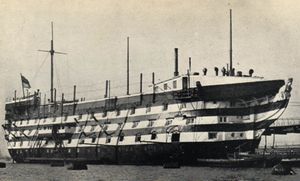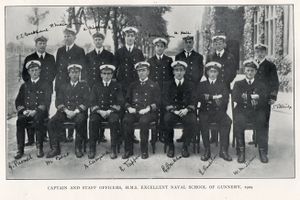Difference between revisions of "H.M.S. Excellent (Gunnery Training School)"
Simon Harley (talk | contribs) |
Simon Harley (talk | contribs) (Made Changes.) |
||
| Line 11: | Line 11: | ||
==History== | ==History== | ||
The foundation of a gunnery school in the [[Royal Navy]] has been attributed to Sir John Bechell and Captain William L. Bowles who had deplored the poor standard of gunnery which could be found after the War of 1812.<ref>Lloyd. ''The Origins of H.M.S. ''Excellent''. pp. 194-195.</ref> In 1830 Commander George Smith, having suggested the creation of a gunnery establishment, was directed by Admiral Sir George Cockburn to find a spot in Portsmouth Harbour where a ship could be moored and fire without inconvenience. Sir Byam Martin, [[Controller of the Navy]], gave Smith permission to choose whatever old ship he needed for the purpose. The ship he chose was the ''Excellent'' which was already moored in the site desired by Smith. He was then appointed to the ''Excellent'', in Cockburn's words, "for the purpose of establishing and carrying into effect a system of gunnery, for the instruction and information of the naval service in that branch of their duty."<ref>"Naval Gunnery" (News). ''The Times''. Friday, 20 August, 1841. Issue '''17754''', col F, pg. 3.</ref> In 1832 Captain Thomas Hastings succeeded Smith and remained in command until 1845, when he was succeeded by Captain Henry Ducie Chads.<ref>Clowes. ''History of the Royal Navy''. '''VI'''. p. 203.</ref> The ''Excellent'', formerly Collingwood's ship at St. Vincent, was broken up in 1834 and replaced by the ''Boyne'', which was in turn replaced by the ''Queen Charlotte'' in 1859, both ships being renamed ''Excellent''.<ref>Lloyd. ''The Origins of H.M.S. ''Excellent''. p. 196.</ref> | The foundation of a gunnery school in the [[Royal Navy]] has been attributed to Sir John Bechell and Captain William L. Bowles who had deplored the poor standard of gunnery which could be found after the War of 1812.<ref>Lloyd. ''The Origins of H.M.S. ''Excellent''. pp. 194-195.</ref> In 1830 Commander George Smith, having suggested the creation of a gunnery establishment, was directed by Admiral Sir George Cockburn to find a spot in Portsmouth Harbour where a ship could be moored and fire without inconvenience. Sir Byam Martin, [[Controller of the Navy]], gave Smith permission to choose whatever old ship he needed for the purpose. The ship he chose was the ''Excellent'' which was already moored in the site desired by Smith. He was then appointed to the ''Excellent'', in Cockburn's words, "for the purpose of establishing and carrying into effect a system of gunnery, for the instruction and information of the naval service in that branch of their duty."<ref>"Naval Gunnery" (News). ''The Times''. Friday, 20 August, 1841. Issue '''17754''', col F, pg. 3.</ref> In 1832 Captain Thomas Hastings succeeded Smith and remained in command until 1845, when he was succeeded by Captain Henry Ducie Chads.<ref>Clowes. ''History of the Royal Navy''. '''VI'''. p. 203.</ref> The ''Excellent'', formerly Collingwood's ship at St. Vincent, was broken up in 1834 and replaced by the ''Boyne'', which was in turn replaced by the ''Queen Charlotte'' in 1859, both ships being renamed ''Excellent''.<ref>Lloyd. ''The Origins of H.M.S. ''Excellent''. p. 196.</ref> | ||
| + | |||
| + | ==Commanding Officers== | ||
| + | Dates of appointment given: | ||
| + | |||
| + | *{{CaptRN}} [[William Henry May|William H. May]], 10 August, 1897.<ref>May Service Record. The National Archives. ADM 196/39. p. 860.</ref> | ||
| + | *Captain [[Arthur Barrow]], 20 January, 1901.<ref>"Naval & Military Intelligence" (Official Appointments and Notices). ''The Times''. Saturday, 29 December, 1900. Issue '''36338''', col C, pg. 9.</ref> | ||
| + | *Captain [[Percy Moreton Scott, First Baronet|Percy M. Scott]], 1 April, 1903.<ref>"Naval & Military Intelligence" (Official Appointments and Notices). ''The Times''. Thursday, 26 February, 1903. Issue '''37014''', col C, pg. 5.</ref> | ||
| + | *Captain [[Frederick Tower Hamilton|Frederick T. Hamilton]], 24 February, 1905.<ref>"Naval and Military Intelligence" (Official Appointments and Notices). ''The Times''. Tuesday, 31 January, 1905. Issue '''37618''', col E, pg. 6.</ref> | ||
| + | *Captain [[Reginald Godfrey Otway Tupper|Reginald G. O. Tupper]], 15 July, 1907.<ref>"Naval and Military Intelligence" (Official Appointments and Notices). ''The Times''. Monday, 10 June, 1907. Issue '''38355''', col B, pg. 6.</ref> | ||
| + | *Captain [[Frederick Charles Tudor Tudor|Frederick C. T. Tudor]], 16 August, 1910.<ref>"Naval and Military Intelligence" (Official Appointments and Notices). ''The Times''. Thursday, 21 July, 1910. Issue '''39330''', col E, pg. 4.</ref> | ||
| + | *Captain [[Morgan Singer]], 1 June, 1912.<ref>"New Director of Naval Ordnance" (Official Appointments and Notices). ''The Times''. Tuesday, 21 March, 1912. Issue '''39904''', col F, pg. 4.</ref> | ||
| + | *Captain [[Cole Cortlandt Fowler]], 19 August, 1914.<ref>''Navy List'' (December, 1914). p. 314.</ref> | ||
==Footnotes== | ==Footnotes== | ||
Revision as of 17:57, 1 July 2010

H.M.S. Excellent, also known as Portsmouth Gunnery School or Whale Island was the British Royal Navy's main gunnery training establishment for most of the nineteenth and twentieth centuries.
History
The foundation of a gunnery school in the Royal Navy has been attributed to Sir John Bechell and Captain William L. Bowles who had deplored the poor standard of gunnery which could be found after the War of 1812.[1] In 1830 Commander George Smith, having suggested the creation of a gunnery establishment, was directed by Admiral Sir George Cockburn to find a spot in Portsmouth Harbour where a ship could be moored and fire without inconvenience. Sir Byam Martin, Controller of the Navy, gave Smith permission to choose whatever old ship he needed for the purpose. The ship he chose was the Excellent which was already moored in the site desired by Smith. He was then appointed to the Excellent, in Cockburn's words, "for the purpose of establishing and carrying into effect a system of gunnery, for the instruction and information of the naval service in that branch of their duty."[2] In 1832 Captain Thomas Hastings succeeded Smith and remained in command until 1845, when he was succeeded by Captain Henry Ducie Chads.[3] The Excellent, formerly Collingwood's ship at St. Vincent, was broken up in 1834 and replaced by the Boyne, which was in turn replaced by the Queen Charlotte in 1859, both ships being renamed Excellent.[4]
Commanding Officers
Dates of appointment given:
- Captain William H. May, 10 August, 1897.[5]
- Captain Arthur Barrow, 20 January, 1901.[6]
- Captain Percy M. Scott, 1 April, 1903.[7]
- Captain Frederick T. Hamilton, 24 February, 1905.[8]
- Captain Reginald G. O. Tupper, 15 July, 1907.[9]
- Captain Frederick C. T. Tudor, 16 August, 1910.[10]
- Captain Morgan Singer, 1 June, 1912.[11]
- Captain Cole Cortlandt Fowler, 19 August, 1914.[12]
Footnotes
- ↑ Lloyd. The Origins of H.M.S. Excellent. pp. 194-195.
- ↑ "Naval Gunnery" (News). The Times. Friday, 20 August, 1841. Issue 17754, col F, pg. 3.
- ↑ Clowes. History of the Royal Navy. VI. p. 203.
- ↑ Lloyd. The Origins of H.M.S. Excellent. p. 196.
- ↑ May Service Record. The National Archives. ADM 196/39. p. 860.
- ↑ "Naval & Military Intelligence" (Official Appointments and Notices). The Times. Saturday, 29 December, 1900. Issue 36338, col C, pg. 9.
- ↑ "Naval & Military Intelligence" (Official Appointments and Notices). The Times. Thursday, 26 February, 1903. Issue 37014, col C, pg. 5.
- ↑ "Naval and Military Intelligence" (Official Appointments and Notices). The Times. Tuesday, 31 January, 1905. Issue 37618, col E, pg. 6.
- ↑ "Naval and Military Intelligence" (Official Appointments and Notices). The Times. Monday, 10 June, 1907. Issue 38355, col B, pg. 6.
- ↑ "Naval and Military Intelligence" (Official Appointments and Notices). The Times. Thursday, 21 July, 1910. Issue 39330, col E, pg. 4.
- ↑ "New Director of Naval Ordnance" (Official Appointments and Notices). The Times. Tuesday, 21 March, 1912. Issue 39904, col F, pg. 4.
- ↑ Navy List (December, 1914). p. 314.
Bibliography
- Lloyd, Christopher (1955). "The Origins of H.M.S. Excellent". The Mariner's Mirror 41 (3): pp. 193-197.


